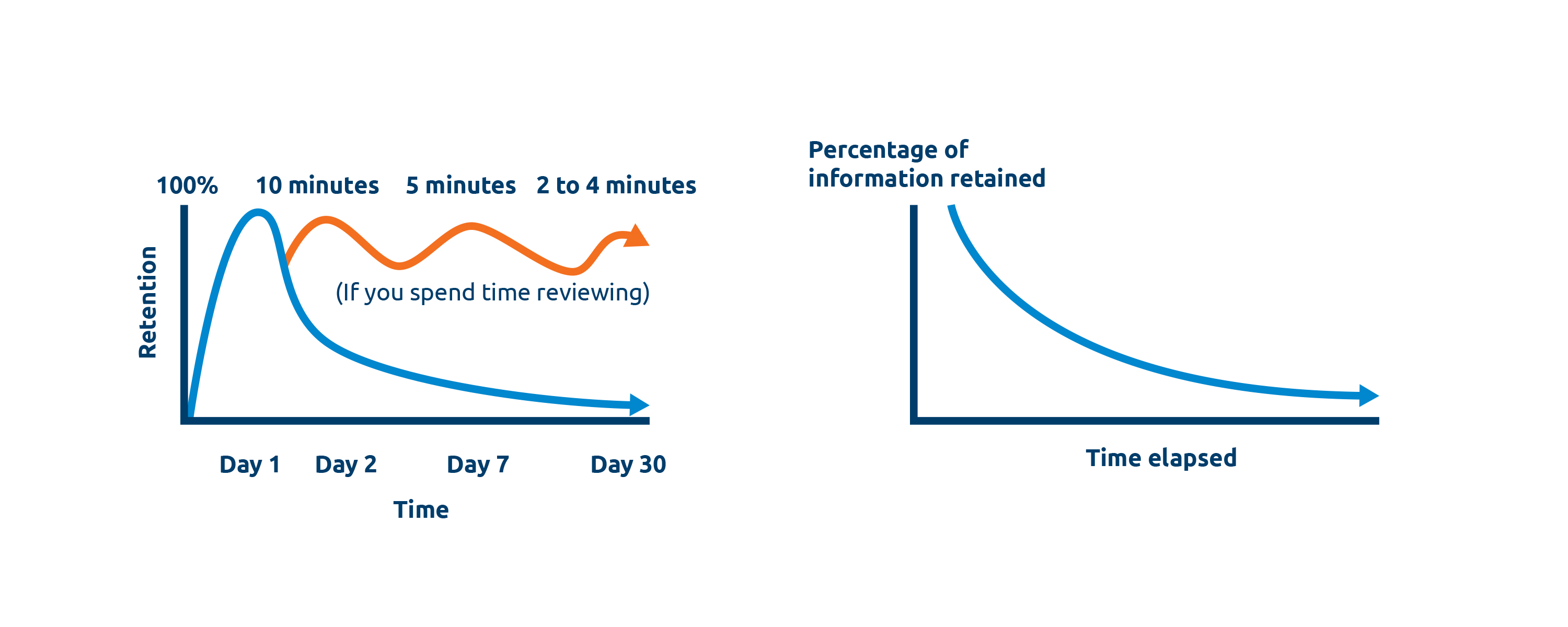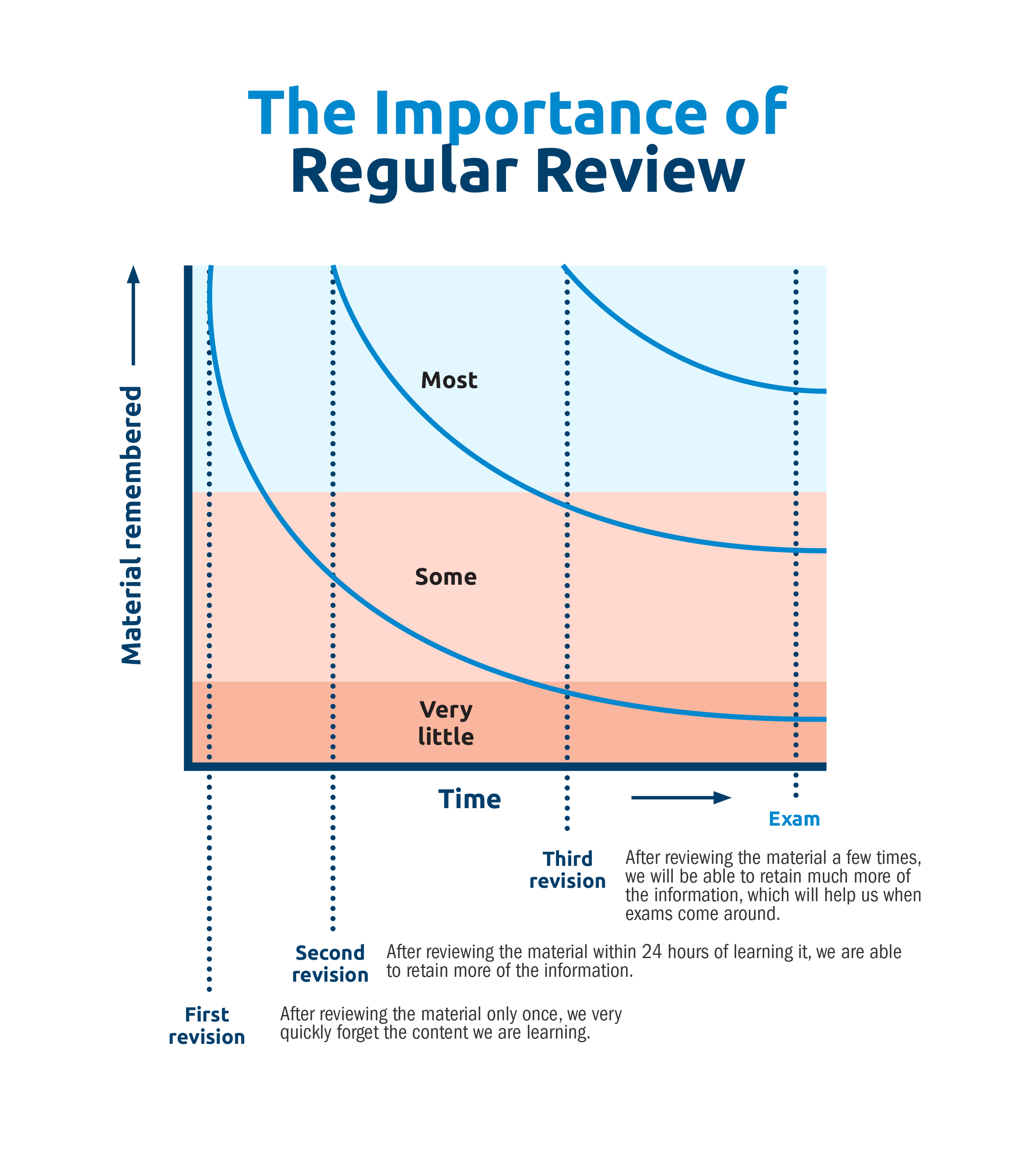Optimize Your Study Session
- How much should I study
- When should I study
- Setting up your study space
- Timer techniques for study sessions
A good rule of thumb to ensure this gradual learning is to spend one to three hours outside of class each week for every one hour of lecture time per course. You cannot learn all the content overnight, so studying a bit gradually over the week is more effective.
For example, if you spend three hours a week in a lecture, you need to spend a minimum of three hours outside of class per week on that particular course.
Every time we take in new information, we want to make sure that we give ourselves enough time to work through that material. Spending the same amount of time reviewing that information again is important for processing what we are learning.
The length of time needed, varies depending on the difficulty of the content, harder content may take longer to study.
Students should spend between 15 to 45 hours outside of class each week on their studies.
A full course load is like a full-time job, some weeks may have a heavier workload than others.
Watch Out for the Forgetting Curve
Hermann Ebbinghaus suggests there is a forgetting curve, this theory claims we start to lose the memory of learned knowledge overtime. This is why you should review notes often.
Have a look at the following image below to understand how this works:

- This curve represents how quickly we forget the information we are learning without regular review.
- Without review, up to 60 per cent of material learned in a lecture is forgotten after 24 hours.
- Within a week, this number increases to about 80 per cent.
- After a month (by the time midterms and exams come around), most of the material is forgotten.
By reviewing information at key moments on the forgetting curve, we can reduce the rate at which we forget information.
Look at the following image to visualize why spacing our learning works:

- The image above shows how learned information is forgotten, and how we can retain more information by reviewing cont
- Notice that we can lessen the effects of the forgetting curve with each study session and retain more of the information we are learning by reviewing the content.
- Our brains remember things more effectively through repetition and redundancy. Our memories are enhanced when we space out our learning over time.
- Our brains also work well when we briefly forget and then practice recalling the information we are trying to learn.
- Notice that we can lessen the effects of the forgetting curve with each study session and retain more of the information we are learning by reviewing the content.
To lessen the forgetting curve, we should review the material within 24 hours. After that, it is a good idea to review our materials regularly.
Slowly adding longer time intervals between study sessions allows us to strengthen our memories. Also, the more time we spend reviewing content earlier on, the less we have to spend going over it later.
The Most Powerful Way to Remember What You Study:
The following video by Thomas Frank from College Info Geek explains more information about the strategy and explains how spacing affects memory:
Other Tips for Pacing Your Studying
- Set achievable study tasks
- If you have just attended six hours of lectures, it would likely be unproductive for you to begin studying immediately.
- If you aren’t sure how long something will take, aim to give yourself more time than needed.
- Learn to prioritize.
- It is important to properly prioritize tasks, one way to do so is by using the urgency-importance matrix.
- Study the most difficult content when you are most alert.
- Tackle tasks that require a lot of concentration when you have the most energy.
- Take breaks!
- Breaks can help raise our motivation levels and allow our brains to digest what we are learning.
- Take breaks that help recharge us, rather than breaks that cause us to feel more mentally stimulated.
- Instead of scrolling through social media go for a short walk.
- Exercise raises our cognitive abilities, and Vitamin D can help with symptoms of fatigue.
- Walks can bring up our mental energy, and allow our brains time to process information.
- Decide on a specific task to work on for the study session.
- Multitasking inhibits our ability to focus, making it challenging to get anything done. Commit to just one task at a time when studying.
- Focus on getting something done rather than attaining perfection.
- Focusing on perfection can build mental resistance and cause struggles with motivation.
- Try doing what you can now, It is far easier to come back and fix up an imperfect mess later than trying to create the perfect product the first time around.
- Remember, the habit of studying for longer hours can only be developed gradually.
- Instead of scrolling through social media go for a short walk.
- If you struggle with studying for longer durations, gradually increase your study time each day. Once you get used to studying a bit longer, you can try increasing your study time again.
Find your space
- Create a clean, organized and distraction-free study space.
- Avoid studying in bed.
- Some students prefer background noise and others prefer silence, try a few different locations to determine what works best for you.
Stock your space
- Anticipate what you will need before sitting down to study.
- Have everything all there and ready to go before you begin studying to limit distractions.
Eliminate distractions
- When we get distracted, it can take several minutes to build back our focus. Be proactive and eliminate distractions before you sit down to study! Here are some tips:
- Hide your phone and remove social media apps during stressful times like midterms and exams.
- Remove your gaming station or TV from your study space if needed.
- Use a lockout browser to study (such as Forest App) to prevent you from scrolling the web.
- Notify family or roommates of study time.
- Use a white noise machine or music to block out external noises. Be careful with distracting music. It is best to use repetitive music, ideally without lyrics.
- If you get distracted while studying, watch the following two videos by Thomas Frank from College Info Geek.
- This video provides an overview of some tools and apps you can use to stop wasting time on the internet.
- This video provides some tips to help you break your phone addiction.
Schedule your study time
- Create a study plan with specific study time blocked off.
Reward yourself
- Building self-discipline is hard work, so be sure to reward yourself when you stick to your study goals.
It is important to take breaks while studying, the breaks should be proportionate to the amount of time you have spent working. Use timer techniques to help monitor how much time you spend on tasks and breaks, help you stick to schedules, and optimize study sessions. These techniques can help prevent burnout and fatigue.
The Pomodoro Technique
The Pomodoro technique is all about setting up a structured routine to take advantage of this fact.
The Pomodoro technique operates on the principle that dividing your work tasks and breaks into regular, short intervals can help you avoid feeling overwhelmed by a task.
To use this technique, you just need a timer, then:
- Choose a task that you need to accomplish and set the timer.
- Continue to work and focus only on the task until the timer goes off.
- Once the timer goes off, take a short break. Try starting with five minutes.
- After four cycles, take a longer break. Move up to 15-30 Minutes.
- Then, start the process again. Adjust the schedule and timings to your preferences, as long as the breaks stay proportionate!
If you are interested in learning more about how Pomodoro works and how you can tweak it to work better for you, watch the following video.
The following website shows how you can integrate the Pomodoro Technique with your to-do lists.
Also, check out the following Pomodoro Timers, which you can use to track your work and breaks.
The Flowtime Technique
The Flowtime Technique is like the Pomodoro Technique, except Pomodoro has a set time with defined short and long breaks in-between.With the Flowtime Technique, you pick one task to focus on and then take breaks when you feel they are needed to achieve a balanced workflow (such as when the task is complete or when your attention starts waning).
To use this technique, you just need a stopwatch. Then:
- Set your timer and start working on one task.
- Stop the timer and note your end time once you complete the task or notice your attention drifting.
- Depending on how long you have worked, take a break proportionate to the amount of time and effort you have given your task.
- Suggested break times:
- For 25 minutes of work or less, take a two to five minute break.
- For 25 to 50 minutes of work, take an eight to ten minute break.
- For 50 to 90 minutes of work, take a 10 to 15 minute break.
- For more than 90 minutes of work, take a 15 to 30 minute break.
- Suggested break times:
Have a break when you need one. Also, remember that you can adjust your break times to suit your schedule; these are just suggestions. If your work is very intense, you might need a longer break to recharge.
Figuring out a suitable study break system can take time, but the overall technique has been found to keep students more motivated. Once you start recording your progress, you also get a better idea of how long upcoming tasks will take you.
References:
Cirillo, Francesco. (2006). The Pomodoro Technique. San Francisco, California: Creative Commons.
Ebbinghaus, H. (1885). Memory: A Contribution to Experimental Psychology. New York: Dover.
“Ebbinghaus’s Forgetting Curve: Why We Keep Forgetting and What We Can Do About It.” (n.d.) Mind Tools. Accessed at: https://www.mindtools.com/pages/article/forgetting-curve.htm
McGee-Thompson, Donna. (19 April 2021). “How to Study efficiently and effectively.” Simon Fraser University. Accessed at: https://www.lib.sfu.ca/about/branches-depts/slc/learning/exam-prep/efficient-effective-study
Murre, J. M. and Dros, J. (2015). “Replication and Analysis of Ebbinghaus’ Forgetting Curve.” PloS one, 10(7).
